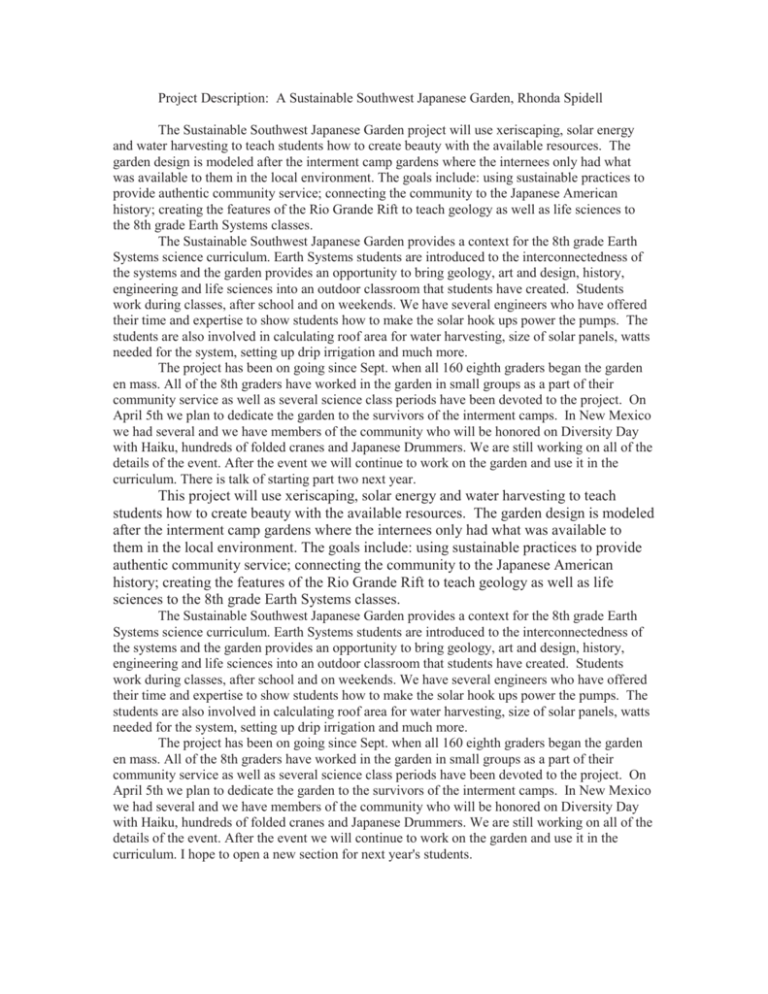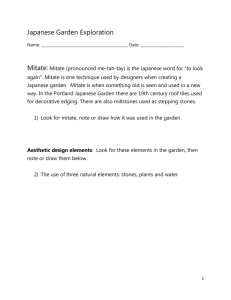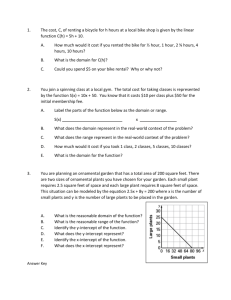Project Description: A Sustainable Southwest
advertisement

Project Description: A Sustainable Southwest Japanese Garden, Rhonda Spidell The Sustainable Southwest Japanese Garden project will use xeriscaping, solar energy and water harvesting to teach students how to create beauty with the available resources. The garden design is modeled after the interment camp gardens where the internees only had what was available to them in the local environment. The goals include: using sustainable practices to provide authentic community service; connecting the community to the Japanese American history; creating the features of the Rio Grande Rift to teach geology as well as life sciences to the 8th grade Earth Systems classes. The Sustainable Southwest Japanese Garden provides a context for the 8th grade Earth Systems science curriculum. Earth Systems students are introduced to the interconnectedness of the systems and the garden provides an opportunity to bring geology, art and design, history, engineering and life sciences into an outdoor classroom that students have created. Students work during classes, after school and on weekends. We have several engineers who have offered their time and expertise to show students how to make the solar hook ups power the pumps. The students are also involved in calculating roof area for water harvesting, size of solar panels, watts needed for the system, setting up drip irrigation and much more. The project has been on going since Sept. when all 160 eighth graders began the garden en mass. All of the 8th graders have worked in the garden in small groups as a part of their community service as well as several science class periods have been devoted to the project. On April 5th we plan to dedicate the garden to the survivors of the interment camps. In New Mexico we had several and we have members of the community who will be honored on Diversity Day with Haiku, hundreds of folded cranes and Japanese Drummers. We are still working on all of the details of the event. After the event we will continue to work on the garden and use it in the curriculum. There is talk of starting part two next year. This project will use xeriscaping, solar energy and water harvesting to teach students how to create beauty with the available resources. The garden design is modeled after the interment camp gardens where the internees only had what was available to them in the local environment. The goals include: using sustainable practices to provide authentic community service; connecting the community to the Japanese American history; creating the features of the Rio Grande Rift to teach geology as well as life sciences to the 8th grade Earth Systems classes. The Sustainable Southwest Japanese Garden provides a context for the 8th grade Earth Systems science curriculum. Earth Systems students are introduced to the interconnectedness of the systems and the garden provides an opportunity to bring geology, art and design, history, engineering and life sciences into an outdoor classroom that students have created. Students work during classes, after school and on weekends. We have several engineers who have offered their time and expertise to show students how to make the solar hook ups power the pumps. The students are also involved in calculating roof area for water harvesting, size of solar panels, watts needed for the system, setting up drip irrigation and much more. The project has been on going since Sept. when all 160 eighth graders began the garden en mass. All of the 8th graders have worked in the garden in small groups as a part of their community service as well as several science class periods have been devoted to the project. On April 5th we plan to dedicate the garden to the survivors of the interment camps. In New Mexico we had several and we have members of the community who will be honored on Diversity Day with Haiku, hundreds of folded cranes and Japanese Drummers. We are still working on all of the details of the event. After the event we will continue to work on the garden and use it in the curriculum. I hope to open a new section for next year's students. In order of support: Japanese Fulbright Memorial Fund (trip to Japan and inspiration) Albuquerque Academy Sustainability Funds contributed by the AA Parents Association ($3000 for plants and landscaping materials) BP A+ for Energy Grant ($1,000 for 1500 gallon cistern and irrigation supplies) PNM Energy Exploration Grant ($1,000 for solar panels and pumps) Over 1000 hours of labor by student community service workers and specialized help from Grounds and Maintenance Department Help from engineers at Sandia Lab, Intel and hopefully the National Lab Day engineer that I was matched with, but haven't heard anything yet. So far I have been getting a lot of ideas and options, but I need someone who can do a little "hand holding" to get through the final stages. Proposal Objectives: Using the garden as a demonstration garden with placards denoting the details of water collection, solar hook up, choice of plant materials and how the rock selection represents the local geology. Using the garden will be used to teach Earth Systems Science by demonstrating the interconnectedness of the Earth’s spheres (hydrosphere, biosphere, geosphere and atmosphere). Using the garden to teach the geology of the region. The design of the garden will illustrate the unique geology of the Rio Grande Rift. Involving students in water conservation by harvesting water from the roof of the library. Engaging students in calculating water collections, rock and solar output needed for the garden. Teaching students how to harness solar energy. Giving students a historical perspective about the lead-up to WWII.








